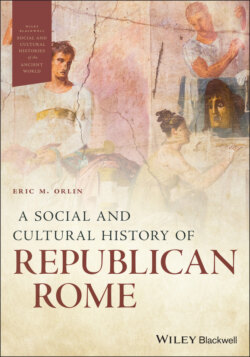Читать книгу A Social and Cultural History of Republican Rome - Группа авторов - Страница 23
Further Reading
Оглавление1 Ancient Authors (Cicero, Livy, Plutarch, et al.)Often the best place to find the texts of ancient authors is within the Loeb Classical Library series, with each author listed by name; translations in the Penguin Classics or Oxford World Classics are also usually reliable. While translations do exist on the Internet, many of these are very old-fashioned, occasionally misleading (as early twentieth-century translators often shied away from taboo topics), and sometimes even incorrect.
2 Chaplin, Jane(2000). Livy’s Exemplary History. Oxford: Oxford University Press.Chaplin’s book is one of a number of recent books that offer new ways of thinking about Livy, whose text provides the foundation for the history of Rome down to the early second century CE. She focuses on how Livy’s use of examples was intended to make history relevant for his Roman audience, even as the meaning of those examples might shift over time.
3 Feldherr, Andrew(Ed.) (2009). The Cambridge Companion to the Roman Historians. Cambridge: Cambridge University Press.Contains essays on a variety of topics, with attention paid both to texts that survive only in fragments as well as sources for history that remained unwritten. Good focus on themes (religion, space, the setting of examples) rather than merely a historian-by-historian description.
4 Keppie, Lawrence(2001). Understanding Roman Inscriptions. London: Routledge.A book designed for the non-specialist, Keppie’s book covers a range of issues, from how the stone-cutter did his work to how to read and date inscriptions. No knowledge of Latin is necessary; Keppie provides all terms needed. Later chapters in the book cover thematic topics such as government, the army, and religion.
5 Laurence, Ray(2012). Roman Archaeology for Historians. London: Routledge.A recent introduction specifically aimed an integrating the study of archaeology and Roman history. The complexity of archaeological data sometimes makes the book’s language difficult, and examples tend to be drawn from Roman Britain (the author’s home country), but the range of topics covered is especially valuable.
6 Lintott, Andrew(2008). Cicero as Evidence: A Historian’s Companion. Oxford: Oxford University Press.A recent concise work focused precisely on using Cicero as a source for Roman history, rather than on the politician or his views. Superbly organized into four sections, on Reading Cicero, Reading Oratory, History in Speeches and Letters, and History and Ideas. A must-read for this topic.
7 Yarrow, Liv M.(2021). The Roman Republic to 49 BCE: Using Coins as Sources. Cambridge: Cambridge University Press.Yarrow’s book introduces students of ancient history to the ways in which coins provide information about the history of the Roman republic. She uses coins to offer insights on early Roman-Italian relations, Roman imperialism, urban politics, and constitutional history, among other topics. This book helps take the mystery out of numismatics, with over 200 illustrations and a guide to research for non-specialists.
